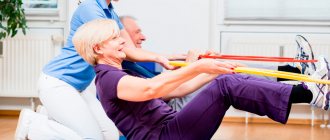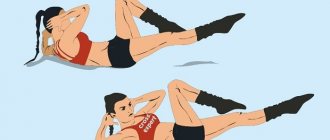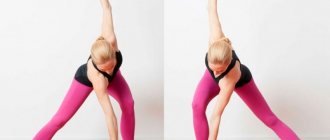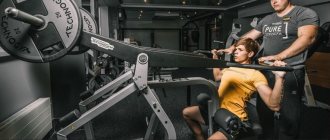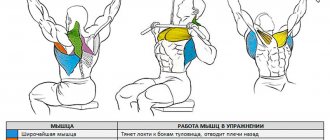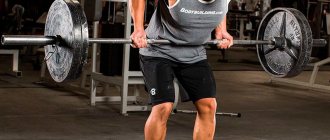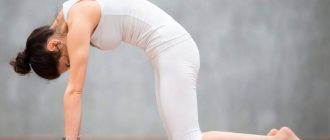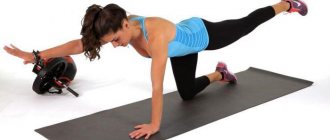Hello, dear readers! There are not many exercises that simultaneously give you slimness, improve the functioning of internal organs and posture. One of these, the simplest and most wonderful, is the boat exercise. It is not as popular as “cat”, but it works no less effectively, believe me!
Here and now we will talk about what it is for and what exactly is the benefit. I will also tell you in detail and clearly how to do it correctly - for safety and effect.
Boat exercise - what is it?
Here is the description: this is a back arch, which is combined with raising straight arms and legs, while lying on your stomach. This movement is extremely popular among those involved in bodyflexing and crossfit. Its other names are “swallow” and “superman”.
Briefly about the advantages: strengthens the spine, gives the muscles of the main groups, flexibility of the back and pleasant fatigue.
This movement cannot be called super simple and easy, but super useful – yes!
Boat exercise for the back and its benefits
Here are the main useful aspects, there are 12 of them:
- The maximum benefit for the back is that it is strengthened, the spine is stretched, and correct posture is formed. Wrong - corrected. This promotes the correct (anatomical) location of the internal organs, which ensures their normal functioning.
- Blood flow is activated in tissues and internal organs.
- The joints are perfectly developed: the spine, as well as the shoulder and hip.
- As a result, the cartilage layer is strengthened, and the production of such important joint fluid is enhanced.
- The muscles of the corset are also strengthened, and the spinal column takes its initially correct position.
- Movement works as a powerful prevention of osteochondrosis.
- The pain and feeling of tension in the back and lower back go away, spasms are relieved, and the muscles regain their natural ability to relax after tension.
- For children, movement is useful because it prevents scoliosis and improves posture.
- The functioning of the digestive system improves.
- Fat deposits in the lower back are lost more intensively.
- The gluteal muscles are perfectly strengthened.
- Good for the abs - the tummy becomes flatter and more toned.
What muscles work? There are many of them: these are the long dorsal muscles, triceps and deltoid muscles, serratus anterior, quadratus lumbar muscles, spinal extensors, flat abdominal muscles, the entire posterior group of thigh muscles, gluteus maximus, soleus muscles.
Did you know that the “boat” is the most accessible home exercise for all of us, which works the deepest muscles.
Moreover, it is precisely those that usually do not have enough load, and which remain unattended with most home and traditional exercises.
What muscles are involved?
The boat is a unique exercise that simultaneously engages the back and abdominal muscles, thereby strengthening them. Since the exercise is not strength, but rather static, you should not expect muscle mass gain or fat burning from it. But at the same time, it is also very important for a harmonious body structure. By doing the pump regularly, you will be able to progress much faster in those exercises where, with heavy weights, without strengthened core muscles, you will be nowhere.
Let's look at what muscles and joints are involved when performing the boat exercise. The main working muscles are:
- Long back muscles.
- Gluteal muscles.
- Flat abdominal muscle.
The peculiarity of this exercise is that the work is carried out not only on the superficial muscle layers, but also on the postural ones. These are internal muscles located deep in the body, near the spine. Thanks to these muscles, a person maintains an upright position when moving and has correct posture when walking. During standard strength training, the internal muscles are much more difficult to work. The boat exercise is ideal for this spruce.
Another advantage is that during the execution of the boat the joints receive absolutely no load . The supine position even eliminates the load from your own weight, both on the joints and on the spine. Therefore, the boat can be performed even by people with severe back problems. But before training, it is still better to first consult with your doctor.
Boat exercise - how to do it?
The technique of performing the movement is not complicated, but it is important to remember the main nuances so as not to harm yourself in the process. Here are step-by-step instructions on how to do everything right:
- You lie on your stomach with your legs together, including your heels and toes.
- Stretch your arms forward straight, palms down.
- Tighten your abs and core.
- Start breathing smoothly, while taking a deep breath, raise your arms and legs at the same time and not very straight (about 30-40 cm, or as much as possible).
- Hold your breath and count to 8-10.
- Now, exhaling smoothly, carefully lower your arms and legs and relax.
This was 1 approach. To get the expected benefits, you should do 3-4 sets.
When training, it is advisable to gradually increase the hold time at the top as the muscles strengthen.
Back boat exercise video:
Reverse boat - a complicated version
This variation not only strengthens your back, but also helps you get a thin waist and better strengthen your hips. Here are the steps step by step:
- The starting position is the same - you again lie on your stomach.
- Hands in front, palms facing down.
- As you inhale, lift your legs and arms up, leaning as much as possible on your stomach and pelvic area.
- Hold your breath for about 10 seconds, and while holding, stretch your body forward and back, stretch your arms forward, and toes back.
- Exhale smoothly and carefully lower your arms and legs.
Here, too, you can start with 4 approaches, gradually increasing the delay time and the number of approaches.
Side boat
You can also do this movement while lying on your side; this option is considered the most effective and difficult. It is more suitable for “advanced users” than for “dummies”. Here are the steps:
- Lie on your side, stretch your legs straight, pointing your toes.
- Lean on your hand, bending it at the elbow.
- The palm of the second hand (which is on top) touch the back of your head.
- As you inhale, smoothly and simultaneously lift your legs and shoulder girdle up, hold at the top point for 10 seconds and smoothly return to the floor.
Here you need to do 4 times on one side and the same number of times on the other.
Users often make common mistakes when performing a movement. The shoulder blades, lower back, and pelvis cannot be lifted off the floor - only the shoulders and legs rise. Do not make sudden movements or jerks under any circumstances! You cannot turn your head - point it straight forward.
Therapeutic effects on the body
The beneficial effect of the “boat” is obvious. People who systematically do this exercise, after a few weeks, lose unwanted centimeters in the waist, hips, etc. In the process, elasticity of the muscles in the abdominal area appears, and correct aesthetic posture is built.
Impact of exercise on muscles, back, spine:
- the mixed navel ring is put in place;
- helps strengthen the solar plexus;
- effectively affects the spinal muscle corset;
- makes posture correct;
- pain syndrome in joint diseases is reduced;
- the production of the cartilage component improves;
- joint mobility is normalized;
- blood circulation in the muscles is normalized;
- the waist and stomach are shaped;
- the work of the heart muscle and overall tone improves.
Who shouldn't do this?
Yes, the “boat” is really simple and accessible to everyone, except those who should not do it. Here are the contraindications to its implementation:
- tachycardia, arrhythmia, various problems with heartbeat;
- dangerously high blood pressure and accompanying nausea, headaches, dizziness;
- exacerbation of spinal diseases;
- recovery period after various back injuries;
- elevated temperature and poor health due to colds;
- malignant formations;
- recovery after heart attack, stroke;
- serious inflammatory processes in the body.
Remember - the nuances listed above are not a reason to completely prohibit any movements. But there is a reason to consult a doctor and get his permission to be active.
Inclusion in the training program
The pump is a gymnastic exercise. This means rapid recovery of the body after its implementation. This is why you can do the movement every day.
However, there are other options.
If you go to the gym, pumping up your lower back in a strength mode (hyperextension, barbell bending, deadlifts), the pump can be done as an easy workout for the lower back on days free from strength exercises.
If you work out at home and the only lower back exercise is the pump, then you can safely do it 4-6 times a week.
The main criterion for training frequency is the restoration of the back muscles.
Since the movement is low-amplitude, this is compensated by a large number of repetitions. As a rule, they perform 15-20 times in one approach. But a repetition range of 20-30 times is also acceptable. It all depends on the level of preparation.
Life story
Did you know that the “boat” is also extremely useful for young mothers?! My friend's wife gave birth to a beautiful baby 5 months ago and he has already gained a lot of weight. The baby is “tame”, and his mother began to have a strong ache in her lower back and back pain - all this due to constantly carrying the baby in her arms.
A trainer she knew advised her to do the pump every day in the morning - on an empty stomach. After just 3 weeks, the back and lower back pain disappeared, and the woman began to feel much better!
That's all! Now you know what the boat exercise is and why it is needed. But, in fact, we all need it! I myself, in the process of preparing this article, began to make a “boat”, and I hope I will not give up this useful business
If you have friends who will definitely benefit from this activity, be sure to share this material with them. The easiest way is through social networks; there are special buttons for this. I will be grateful to you for your likes and subscriptions to the channel, as well as for your comments on the materials. I wish you all good health, goodbye!
Symptoms of intervertebral hernia
With atrophy of the muscular-ligamentous corset, the entire load falls on the vertebrae with intervertebral discs and facet joints. If at the same time there is excess weight and a person begins to lift weights (say, 30 kg), the bone and cartilage are faced with the impossible task of maintaining this weight (we are talking only about cartilage and bone). Atrophic muscles and ligaments do not want to participate in this work, because we did not play sports. Excess fat tissue additionally and without lifting weights leads to excess load, and then they decided to bring 2 buckets of water to the bathhouse or decided to move the closet. The entire burden falls on the PDS. And what happens in it? Protective mechanism - spondylosis and spondyloarthrosis, protrusions develop.
Spondylosis is a protective mechanism that consists of the following:
- With excessive axial load, the area of the vertebra begins to increase in order to support the excess weight. This increased area of bone tissue is called spondylosis (osteophytes - bone growths). They are located over the entire surface of the vertebral body. Danger can only arise when these bone growths begin to put pressure on the neurovascular formations of the spine. Similar problems arise in the facet joints (facets) - spondyloarthrosis.
- We have analyzed the main mechanism and causes of the formation of a herniated disc. Now let's look at the mechanisms of treatment. In order to understand how to treat, you need to discuss one nuance - the anatomy of the location of the nerves (roots)
So, in the spinal motion segment of the lumbar spine there is a spinal canal where the main nerve trunk passes through - the cauda equina and the lateral recess, which is located on the side of the spinal canal (the nerve root emerges from it).
Why do we need to know this? In order to understand why some patients have large hernias and do not undergo surgery, while others, even with a small hernia of 5 mm, require surgery.
Very often, a patient comes for a consultation and says that a friend also had a hernia measuring 5 mm and he cured it, or a relative had a hernia measuring 1 cm and he did not undergo surgery, but went somewhere to have the hernia repaired and everything is fine with him . In all cases , there is one parameter that no one takes into account - the size of the “room” where this hernia is located. By room we mean the spinal canal and lateral recess.
The lateral recess (also called the intervertebral foramen) , from where the root emerges, has its own size. It is different for each person, and the size determines the likelihood of the hernia putting pressure on the nerve or whether there is room for the nerve to be displaced. It is precisely because of the size of the lateral recess that the main confusion occurs among patients and neurologists. One patient with a hernia measuring 1 cm can walk and be free from pain, while another is brought in by ambulance and carried on a stretcher with a hernia of the same size. There is an explanation: in the first patient, the lateral recess was large, and the nerve shifted away from the hernia to the side, and in the second patient, the size of the lateral recess did not allow the root to move and the hernia compressed it. As a result of the compression, the nerve became red, swollen and painful, which led to hospitalization.
So, I remind you again: the size of the lateral recess is important, not just the hernia! Only an experienced neurosurgeon or neurologist can determine the size of the lateral recess and decide on treatment tactics after examining the patient and his photographs. Not all hernias, even very large ones, require surgical treatment. I would like to give an example of treating a patient with a large hernia: A 33-year-old patient came for a consultation with complaints of lower back pain. The pain is constant. On examination there are symptoms of slight tension of the root. MRI images show a large hernia at L4-L5. All previous consultations were limited to surgical treatment. The patient was prescribed an orthopedic regimen, conservative treatment and physical therapy. He was observed for a year at the Central Clinical Hospital and underwent several stages of conservative treatment. The patient complied with all recommendations. After 10 months, a control photograph was taken, in which it became noticeable that the hernia had “resolved.”
